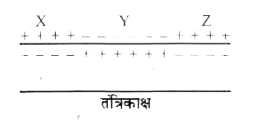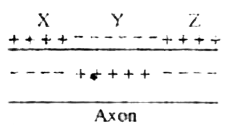During the propagation of a nerve impulse. the action potential results from the movement of :
K+ions from intracellular fluid to extracellular fluid
Na+ ions from extracellular fluid to intra cellular fluid
K+ ions from extracellular fluid to intra cellular fluid
Na+ ions from intracellular fluid to extra cellular fluid
The correct Answer is:B
Step-by-Step Solution:
1. Understanding Action Potential:
- Action potential is a rapid change in the electrical potential across a neuron's membrane, which is essential for the propagation of nerve impulses.
2. Role of Ion Movement:
- The generation of action potential is primarily due to the movement of ions, specifically sodium (Na⁺) and potassium (K⁺) ions, across the neuron's membrane.
3. Voltage-Gated Channels:
- The neuron's plasma membrane contains voltage-gated ion channels that open in response to changes in membrane potential.
- Sodium channels open when the membrane potential reaches a threshold, allowing Na⁺ ions to flow into the neuron.
4. Influx of Sodium Ions:
- Sodium ions (Na⁺) are predominantly found in the extracellular fluid. When the sodium channels open, Na⁺ ions move from the extracellular fluid into the intracellular fluid, leading to depolarization of the membrane.
5. Depolarization:
- The influx of Na⁺ ions causes the inside of the neuron to become more positively charged compared to the outside, which is the key characteristic of action potential.
6. Conclusion:
- Based on the movement of ions during the action potential, the correct answer to the question is that action potential results from the movement of Na⁺ ions from the extracellular fluid to the intracellular fluid.
Final Answer:
- The action potential results from the movement of Na⁺ ions from extracellular fluid to intracellular fluid (Option B).
---
- Action potential is a rapid change in the electrical potential across a neuron's membrane, which is essential for the propagation of nerve impulses.
- The generation of action potential is primarily due to the movement of ions, specifically sodium (Na⁺) and potassium (K⁺) ions, across the neuron's membrane.
- The neuron's plasma membrane contains voltage-gated ion channels that open in response to changes in membrane potential.
- Sodium channels open when the membrane potential reaches a threshold, allowing Na⁺ ions to flow into the neuron.
- Sodium ions (Na⁺) are predominantly found in the extracellular fluid. When the sodium channels open, Na⁺ ions move from the extracellular fluid into the intracellular fluid, leading to depolarization of the membrane.
- The influx of Na⁺ ions causes the inside of the neuron to become more positively charged compared to the outside, which is the key characteristic of action potential.
- Based on the movement of ions during the action potential, the correct answer to the question is that action potential results from the movement of Na⁺ ions from the extracellular fluid to the intracellular fluid.
- The action potential results from the movement of Na⁺ ions from extracellular fluid to intracellular fluid (Option B).
टॉपर्स ने हल किए ये सवाल
- NEURAL CONTROL AND COORDINATIONBook:AAKASH SERIESChapter:NEURAL CONTROL AND COORDINATIONExercise:EXERCISE-II
Explore 47 Videos
- MOLECULAR BASIS OF INHERITANCEBook:AAKASH SERIESChapter:MOLECULAR BASIS OF INHERITANCEExercise:Exercise-III (Previous AIPMT/NEET Questions) (AFMC)
Explore 5 Videos
- ORGANISMS AND POPULATIONSBook:AAKASH SERIESChapter:ORGANISMS AND POPULATIONSExercise:EXERCISE-III (PREVIOUS AIPMT/NEET QUESTIONS)
Explore 35 Videos
समान प्रश्न
In which animal, nerve cell is present but brain is absent ?
View SolutionRemoval of introns and joining the exons in a defined order in a transcription unit is called:
View SolutionAsymptote in a logistic growth curve is obtained when
View SolutionEstimate the order of the speed of propagation of an potential or nerve impulse -
View SolutionDuring conduction of nerve impulse
View SolutionAssertion :- Threshold stimulus is required for propagation of impulse Reason:- Threshold stimulus produce action potential therefore conduction of impulse occur.
View SolutionMinerals essential for nerve impulse propagation are
View Solutionतंत्रिका आवेग के प्रेषण के दौरान क्रिया विभव से, किसकी गति कहाँ को होती है ?
View Solutionएक तंत्रिका तंतु से तंत्रिकीय आवेग के संवहन के दौरान, प्लाज्मा झिल्ली की आन्तरिक सतह के विभव में किस प्रकार का विद्युत आवेश होगा?
View Solutionदिया गया चित्र तंत्रिकाक्ष झिल्ली और तंत्रिका आवेग के प्रसार को दर्शाता है। तंत्रिका आवेग के प्रसार की दिशा क्या होगी?

View Solutionतंत्रिका आवेगों के संचरण के दौरान आन्तरिक भित्ति के विभव में निम्न प्रकार के परिवर्तन होते हैं।
View SolutionThe given figure illustrates the axonal membrane and propagation of nerve impulse. What will be the direction of propagation of the nerve impulse?

View SolutionWhat is action potential? Describe how the nerve impulse is propagated in a non-myelinated and myelinated nerve fibre.
View Solutionएक तंत्रिका आवेग के संचरण के दौरान, क्रिया विभव किसकी गति के परिणामस्वरूप होता है?
View SolutionThe correct path of the movement of nerve impulses in the following diagram is
View SolutionThe process of responding to peripheral nerve stimulation that occurs involuntarily is referred to as (a) Reflex action (b) Action potential (c) Nerve impulses (d) Co - ordination
View Solution
